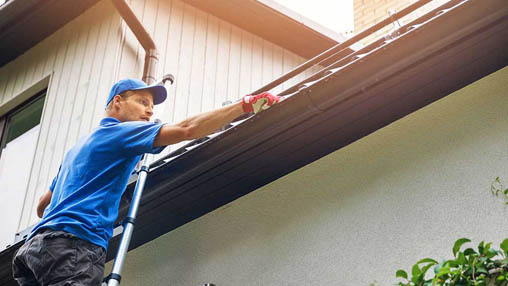
Earn cash back
after close!
With Home Connect, you could earn $350 to $9,500 cash back after close.
For many people, one of the benefits of homeownership is having the opportunity to use their home equity to access needed cash. While there are many options to get that money into your piggy bank, an attractive option for many is a Cash-Out Refinance.
What Is a Cash-Out Refinance?
A cash-out refinance takes place when a homeowner secures a new loan to replace their current mortgage, for more than the amount currently owed. The homeowner can then use the additional cash for many things such as paying off higher interest debt like credit cards or for making home renovations.
This differs from a rate and term refinance, where the original loan is replaced with a new loan, typically with a lower interest rate and a new set of terms. A rate and term refinance does not allow a homeowner to receive any cash-back at close or to pay off any debts, other than the mortgage. A homeowner with an adjustable-rate mortgage (ARM), for example, could use a rate and term refinance to replace the ARM with a 30-year-fixed-rate loan so they can have predictable payments in the future. It offers long-term benefits, but may not be the right choice for someone who has an immediate need for cash.
Over the years, cash-out refinance loans got a bad rap, especially during the housing boom, when too many homeowners relied on the method to stay above water. Following the recession, tighter lender restrictions and better consumer education has helped cash-out refinances become a more responsible way to borrow. In fact, while cash-out refinances accounted for roughly 80% of refinanced mortgages during the mid-2000s, they make up just 41.5% of refinancings in recent years (as of September 2018).
Home values continue to rise in many regions of the country, and this increase in home values has led to the resurgence of cash-out refinancing among some lenders.
Benefits of Cash-Out Refinance Loans
Here are a few possible benefits of a cash-out refinancing:
- Lower your monthly bills: A cash-out refinance can put money back into your pocket every month. Let’s say you currently pay $2,000 on your mortgage, $500 on a car and $600 on a truck. If you can pay off your automobiles with equity from your home, you could be saving $1,100 per month in auto payments and potentially reducing overall interest.*
- Consolidate credit card debt: With credit cards paid down, or paid off in full, credit utilization goes way down, which could also have a positive impact on your credit.
- Add value to your home: If you’re thinking about remodeling, using a cash-out refinance to fund the project is smart. It doesn’t just save you from using a credit card, it allows you to take the equity you’ve built in your home and reinvesting it with a renovation, which can help increase the value of your home long term.
When used appropriately, cash-out refinancing can be a great option to leverage home equity. Yet, similar to making any other major financial decisions, each of its pros and cons must be weighed.
*By refinancing your existing loan, your total finance charges may be higher over the life of the loan.
Wondering What a Cash-Out Refinance Might Look Like for You?
Let’s take a look at Susan. She is considering a cash-out refinance loan*** to consolidate her debt and lower her monthly expenses. The current value of her home is $300,000, and the current balance on her mortgage is $200,000. In addition to her mortgage, she also owes:
- $32,000 on a personal loan at 4.21%
- $8,000 in credit card debt at 17.68%
Currently, her personal loan payments are $515 a month, and she makes the minimum monthly payment on her credit card, which is $200. Here is what a cash-out refi would look like for Susan:
| Current Loan | Cash-Out Refinance Loan | |
|---|---|---|
| Monthly Mortgage Payment | $959** | $1163** |
| Loan Amount | $300,000 | $240,000 |
| Loan Term | 30-year | 30-year |
| Mortgage Interest Rate | 4.00% | 4.00% |
| APR | 4.138% | 4.256% |
| Personal Loan Monthly Payments | $515 | N/A |
| Personal Loan Interest | 4.21% | N/A |
| Credit Card Monthly Payments | $200 | N/A |
| Credit Card Interest Rate | 17.68% | N/A |
| Total Monthly Payments | $1674 | $1163 |
**Principal and interest only
In this example, If Susan consolidated her debt, her new loan would be $240,000 and she would have an extra $511/month in her pocket! In addition to reducing yearly interest on her $32,000 personal loan, she reduced the rate on her $8,000 balance by 13.66% — huge savings!
A Cash-Out Refi Isn’t an ATM
It’s important for homeowners to understand why they are opting for a cash-out refinance loan. Would it be used to replace your leaky roof? To buy a new car? To consolidate debt? Or would the money be used to fund an exotic island vacation instead? If any of your reasons fall into the latter, it might be more reasonable to consider alternative financing.
When you choose a refinance loan, you are putting your home on the line. Your house will be put up for collateral, and full, on-time payments must become a top priority. If you are using a cash-out refinance to remedy bad financial habits, you could find yourself in a heap of trouble.
There are some situations where taking cash out of your home equity is smart, or even necessary, but it’s something you should definitely think about. If you don’t really need the money, it probably makes more sense to go the route of a rate and term refinance, or no refinance.
Look for Changes in Your Interest Rate
In the housing boom, many people turned to cash-out refinancing to replace soaring interest rates with lower ones. Today, low mortgage rates have kept many homeowners at bay. In fact, in some cases, choosing a cash-out to refinance option may increase your interest rate, so it’s important to consider your cost as well as your return.
Because a cash-out refinance restarts the amortization process, you may be increasing your lifetime interest rate. With a cash-out refinance, you will pay a new interest rate on the full new balance — not just on the newly borrowed cash. This also means that your monthly payment resets to mostly paying interest and not reducing the principal balance, much like when you secured your home mortgage the first time around. A way to avoid paying more interest overtime is using shorter term options.
Don't Forget About Closing Fees and Costs
You will also have to pay closing costs and fees on a refinance (similar to when you purchased your home), which can run anywhere from hundreds of dollars, to several thousand. Of course, the smaller the cash-out balance, the less attractive your return on costs will be.
Take a close look at costs and weigh it against how you plan to use the funds and the amount you’re planning to take out. Ordinarily, borrowers refinance to obtain better loan terms — a lower interest rate, a shorter term, or a predictable monthly payment when switching from an adjustable rate mortgage (ARM) to a fixed-rate loan.
By refinancing out of your existing interest rate, you generally increase the term of your mortgage (unless you choose a shorter loan term), while changing the interest rate and payment. In some cases, it may be better to preserve your existing low rate mortgage, by borrowing with a home equity loan, or even better, a home equity line of credit (HELOC), where you have continuous open access to funds.
Only you can decide what financing is best for you. Don’t be shy about reaching out to your lender — call a Pennymac Loan Officer or apply online. An expert opinion can help you better consider your options, and help you get your finances in order.
***Pennymac loan transaction example: Rate of 4.0% (4.256% APR) as of 8.12.19 is for a $240,000 Conventional conforming, 30 year fixed rate loan in CA. 360 equal monthly payments of $1,163 does not include tax and insurance costs and assumes 2.336 discount points, borrower FICO score of 740 or greater, a loan-to-value (LTV) ratio of 80% or less on a single family, owner-occupied residential property. Lifetime interest paid calculated based on interest rate, term and loan balance. Rates and APRs may vary depending on loan details including but not limited to points, loan amount, loan-to-value, borrower credit, income, expenses, property type, occupancy and geography. Unless stated otherwise, closing costs will apply and can vary by state. This is not a commitment to lend, but for illustrative purposes only.
Share
Categories





